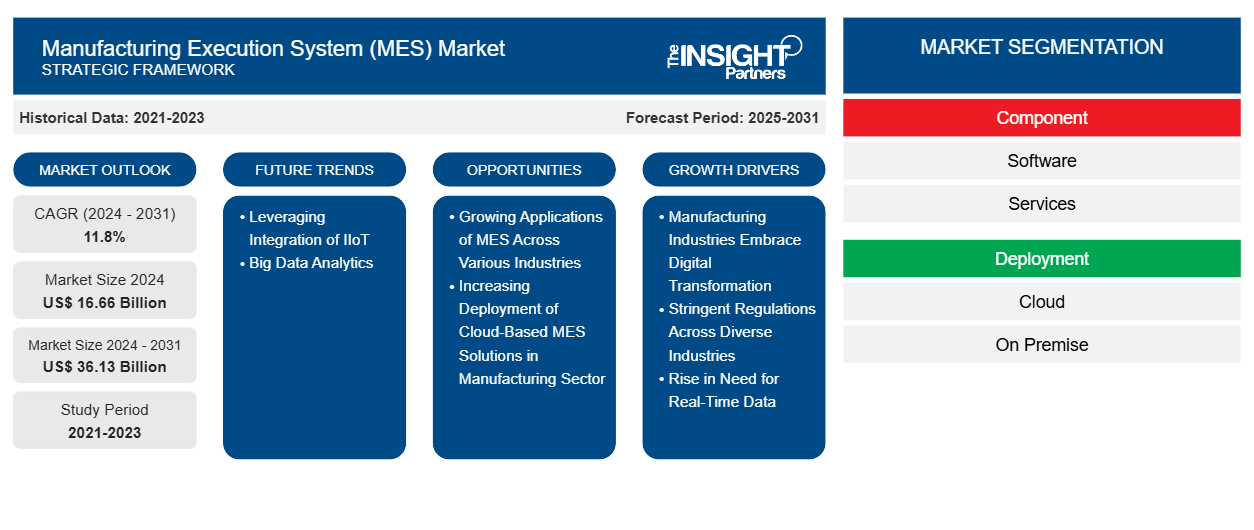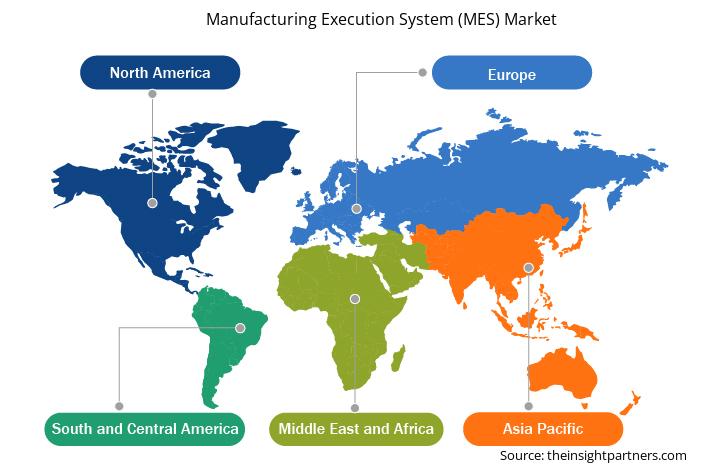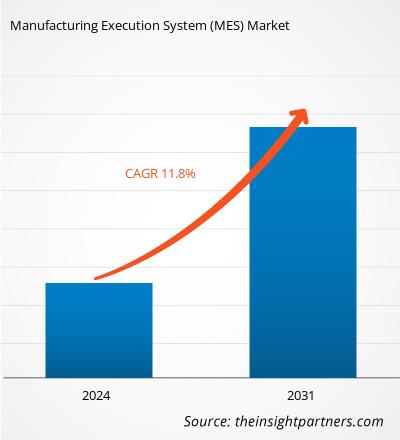Le marché des systèmes d'exécution de fabrication (MES) était évalué à 16,66 milliards de dollars US en 2024 et devrait atteindre 36,13 milliards de dollars US d'ici 2031 ; son TCAC devrait atteindre 11,8 % entre 2024 et 2031. L'intégration de l'IIoT et de l'analyse du Big Data devrait rester une tendance clé du marché.
Analyse du marché des systèmes d'exécution de fabrication (MES)
Des facteurs tels que la transformation numérique des industries manufacturières, la réglementation stricte dans divers secteurs et le besoin croissant de données en temps réel stimulent la croissance du marché des systèmes d'exécution de production (MES) . L'utilisation croissante des MES dans divers secteurs et l'essor des solutions MES cloud dans le secteur manufacturier devraient créer des opportunités d'expansion pour ce marché. De plus, l'intégration de l'IIoT et de l'analyse du Big Data devrait définir de nouvelles tendances pour ce marché.
Aperçu du marché des systèmes d'exécution de fabrication (MES)
Un système d'exécution de production (MES) est un logiciel complet et dynamique qui surveille, suit, documente et gère l'ensemble du processus de fabrication, des matières premières aux produits finis. Un MES sert de couche fonctionnelle entre les systèmes de planification des ressources de l'entreprise (ERP) et de contrôle des processus, fournissant aux décideurs les données nécessaires à l'amélioration de l'efficacité de l'usine. Le MES permet aux entreprises de suivre et de contrôler l'ensemble du processus de fabrication, de la réception des matières premières à la livraison des produits finis . Cela comprend le traitement des ordres de travail, le contrôle de la qualité des produits, le suivi des performances des machines et la collecte de données tout au long du processus de production.
Un logiciel MES permet de gérer, de surveiller et de coordonner en temps réel les processus physiques et le personnel impliqués dans la transformation des matières premières en produits intermédiaires et/ou finis. De plus, il fournit des données exploitables qui aident les décideurs du secteur industriel à comprendre comment optimiser les conditions d'exploitation des usines afin d'augmenter la production. Un logiciel MES fait le lien entre les systèmes PLM, ERP (informatique) et les machines (opérationnelles). Cette couche logicielle améliore l'efficacité et la qualité du processus de production, ce qui se traduit par une productivité et une rentabilité accrues.
Personnalisez ce rapport en fonction de vos besoins
Vous bénéficierez d'une personnalisation gratuite de n'importe quel rapport, y compris des parties de ce rapport, ou d'une analyse au niveau des pays, d'un pack de données Excel, ainsi que de superbes offres et réductions pour les start-ups et les universités.
Marché des systèmes d'exécution de fabrication (MES) : perspectives stratégiques

- Obtenez les principales tendances clés du marché de ce rapport.Cet échantillon GRATUIT comprendra une analyse de données, allant des tendances du marché aux estimations et prévisions.
Moteurs et opportunités du marché des systèmes d'exécution de fabrication (MES)
Des réglementations strictes dans divers secteurs
Le MES garantit la conformité industrielle grâce à une traçabilité complète et à l'enregistrement des données. Il enregistre des informations détaillées sur les matières premières, les composants, les procédés et les opérateurs impliqués dans la fabrication. Ces données permettent aux fabricants de respecter les critères réglementaires et de maintenir des normes élevées. Par exemple, le MES peut documenter automatiquement chaque étape du processus de fabrication, créant ainsi une piste d'audit nécessaire aux inspections réglementaires. Il analyse également les paramètres de contrôle qualité en temps réel pour garantir la conformité des produits aux normes industrielles. En cas d'écart, le MES peut envoyer des alertes et prendre des mesures correctives pour garantir la conformité. Le MES est au cœur des opérations quotidiennes du secteur pharmaceutique, permettant une gestion précise et en temps réel de tous les aspects du processus de fabrication. Dans l'industrie pharmaceutique, le MES facilite la gestion des dossiers de lots électroniques (EBR) conformément aux critères rigoureux des Bonnes Pratiques de Fabrication (BPF). Le déploiement d'un système EBR permet au MES de garantir la documentation précise de chaque étape de production, réduisant ainsi le risque d'erreurs humaines et simplifiant la gestion quotidienne des opérations. De plus, le MES utilisé dans l'industrie agroalimentaire respecte toutes les normes légales et sanitaires, notamment l'analyse des risques et la maîtrise des points critiques (HACCP). Dans l'industrie agroalimentaire, le déploiement d'un système MES se fait de préférence par étapes, en commençant par les lignes ou zones de production choisies afin de minimiser les perturbations du processus. Ainsi, les normes réglementaires strictes en vigueur dans divers secteurs stimulent la croissance du marché des systèmes d'exécution de production (MES).
Applications croissantes du MES dans divers secteurs
Les solutions MES peuvent être mises en œuvre et modifiées pour répondre aux besoins spécifiques de différents secteurs, tels que l'automobile, l'électronique et l'industrie pharmaceutique. Cependant, la fonction fondamentale d'un MES reste la même dans tous les secteurs. Un système d'exécution de production (MES) permet de s'adapter à un secteur automobile de plus en plus complexe et en constante évolution, et de mieux aligner les opérations de fabrication sur les besoins du marché. Pour ce faire, un MES utilise trois fonctionnalités clés : la gestion des opérations, la gestion de l'information et une passerelle d'intégration. L'utilisation d'un MES permet aux équipementiers automobiles de rester à l'avant-garde des tendances du secteur. Dans la construction automobile, le MES joue un rôle essentiel dans la coordination des chaînes de montage complexes. Il suit la progression des véhicules sur la chaîne, surveille la disponibilité des composants et synchronise les opérations sur les différents postes de travail. Les fabricants de batteries peuvent améliorer leur gestion de la qualité grâce à une traçabilité totale, du mélange à la formulation. Les fabricants de pneus peuvent maintenir leurs normes d'efficacité et de qualité tout en gérant des mélanges de pneus complexes. Un MES peut apporter des améliorations quantifiables dans de nombreux domaines. Selon Rockwell Automation, le MES permet de réduire les rebuts jusqu'à 8 %, les délais d'exécution jusqu'à 45 %, la durée du cycle jusqu'à 45 %, les coûts de main-d'œuvre jusqu'à 50 % et les taux de rejet jusqu'à 75 %. De ce fait, il trouve des applications dans divers secteurs. Ainsi, son utilisation croissante dans divers secteurs devrait créer des opportunités lucratives pour la croissance du marché.
Analyse de segmentation du rapport sur le marché des systèmes d'exécution de fabrication (MES)
Les segments clés qui ont contribué à l’élaboration de l’analyse du marché des systèmes d’exécution de fabrication (MES) sont les composants, le déploiement, la taille de l’organisation, le type de licence, le canal de vente et l’utilisateur final.
- En fonction des composants, le marché est segmenté en logiciels et en services. Le segment des services est lui-même subdivisé en services professionnels et services gérés. Le segment des logiciels a dominé le marché en 2024.
- En termes de déploiement, le marché est segmenté entre le sur site et le cloud. Le cloud est lui-même subdivisé en cloud privé, cloud public et cloud hybride. Le cloud détenait la plus grande part de marché en 2024.
- Le marché des systèmes d'exécution de production (MES), selon la taille des organisations, se divise en grandes entreprises et en PME. Le segment des grandes entreprises a dominé le marché en 2024.
- Selon le type de licence, le marché des systèmes d'exécution de production (MES) est segmenté en systèmes sous licence et systèmes par abonnement. Le segment des systèmes par abonnement a dominé le marché en 2024.
- En fonction du canal de vente, le marché est divisé en ventes directes, partenaires de distribution et fournisseurs tiers. Le segment de la vente directe a dominé le marché en 2024.
- En fonction de l'utilisateur final, le marché est segmenté en industrie de transformation et industrie discrète. L'industrie de transformation est subdivisée en agroalimentaire, pétrole et gaz, chimie, pâtes et papiers, chimie, énergie et électricité, produits pharmaceutiques et sciences de la vie, traitement de l'eau et des eaux usées, entre autres. L'industrie discrète est elle-même subdivisée en automobile, électronique, semi-conducteurs, aérospatiale et défense, biens de consommation courante, dispositifs médicaux, entre autres. L'industrie discrète a dominé le marché en 2024.
Analyse des parts de marché des systèmes d'exécution de fabrication (MES) par zone géographique
- Le marché des systèmes d'exécution de production (MES) est segmenté en cinq grandes régions : Amérique du Nord, Europe, Asie-Pacifique (APAC), Moyen-Orient et Afrique (MEA), et Amérique du Sud et centrale. En 2024, l'Amérique du Nord a dominé le marché des systèmes d'exécution de production (MES). L'Europe est le deuxième contributeur mondial au marché des systèmes d'exécution de production (MES), suivie de l'Asie-Pacifique.
- Le marché des systèmes d'exécution de production (MES) en Amérique du Nord est segmenté entre les États-Unis, le Canada et le Mexique. L'Amérique du Nord détient une part de marché significative, tirée par son tissu manufacturier de pointe et l'adoption précoce des technologies de l'Industrie 4.0. Les États-Unis, en particulier, abritent de nombreux éditeurs de logiciels MES, dont des leaders mondiaux comme Rockwell Automation et Honeywell International Inc. L'adoption des MES en Amérique du Nord est répandue dans des secteurs tels que l'automobile, l'aérospatiale, la pharmacie et l'électronique. L'importance croissante accordée à l'analyse des données en temps réel, à l'efficacité de la production et à la conformité réglementaire stimule la demande de solutions MES. De plus, le marché nord-américain connaît une croissance substantielle, les fabricants et les autorités gouvernementales reconnaissant de plus en plus les avantages du suivi de la production en temps réel et de l'optimisation des processus. De plus, les incitations gouvernementales en faveur de la transformation numérique et de l'adoption de l'Industrie 4.0 accélèrent la demande de systèmes MES, alimentant ainsi la croissance du marché.
Aperçu régional du marché des systèmes d'exécution de fabrication (MES)
Les analystes d'Insight Partners ont analysé en détail les tendances et les facteurs régionaux influençant le marché des systèmes d'exécution de la production (MES) au cours de la période de prévision. Cette section aborde également les segments et la répartition géographique du marché des systèmes d'exécution de la production (MES) en Amérique du Nord, en Europe, en Asie-Pacifique, au Moyen-Orient et en Afrique, ainsi qu'en Amérique du Sud et en Amérique centrale.

- Obtenez les données régionales spécifiques au marché des systèmes d'exécution de fabrication (MES)
Portée du rapport sur le marché des systèmes d'exécution de fabrication (MES)
| Attribut de rapport | Détails |
|---|---|
| Taille du marché en 2024 | 16,66 milliards de dollars américains |
| Taille du marché d'ici 2031 | 36,13 milliards de dollars américains |
| TCAC mondial (2024 - 2031) | 11,8% |
| Données historiques | 2021-2023 |
| Période de prévision | 2025-2031 |
| Segments couverts | Par composant
|
| Régions et pays couverts | Amérique du Nord
|
| Leaders du marché et profils d'entreprises clés |
|
Densité des acteurs du marché des systèmes d'exécution de production (MES) : comprendre son impact sur la dynamique des entreprises
Le marché des systèmes d'exécution de production (MES) connaît une croissance rapide, portée par une demande croissante des utilisateurs finaux, liée à l'évolution des préférences des consommateurs, aux avancées technologiques et à une meilleure connaissance des avantages de ces produits. Face à cette demande croissante, les entreprises élargissent leur offre, innovent pour répondre aux besoins des consommateurs et capitalisent sur les nouvelles tendances, ce qui alimente la croissance du marché.
La densité des acteurs du marché désigne la répartition des entreprises opérant sur un marché ou un secteur particulier. Elle indique le nombre de concurrents (acteurs) présents sur un marché donné par rapport à sa taille ou à sa valeur marchande totale.
Les principales entreprises opérant sur le marché des systèmes d'exécution de fabrication (MES) sont :
- SAP SE
- ABB Ltd
- Dassault Systèmes SE
- Schneider Electric SE
- Emerson Electric Co
- General Electric Co
Avertissement : Les entreprises répertoriées ci-dessus ne sont pas classées dans un ordre particulier.

- Obtenez un aperçu des principaux acteurs du marché des systèmes d'exécution de fabrication (MES)
Actualités et développements récents du marché des systèmes d'exécution de fabrication (MES)
Le marché des systèmes d'exécution de production (MES) est évalué en collectant des données qualitatives et quantitatives issues d'études primaires et secondaires, incluant des publications d'entreprises importantes, des données d'associations et des bases de données. Voici quelques-unes des évolutions du marché des systèmes d'exécution de production (MES) :
- Emerson Automation Solutions a annoncé l'élargissement de son partenariat avec Informetric Systems Inc. Emerson a intégré InfoBatch au système d'exécution de fabrication Syncade. Les clients d'Emerson peuvent désormais agréger les données de Syncade, DeltaV et de bases de données/historiseurs tiers grâce à la suite de reporting InfoBatch.
(Source : Emerson Automation Solutions, communiqué de presse, novembre 2024)
- GE Digital, partie intégrante du portefeuille d'activités énergétiques de GE Vernova, a annoncé de nouvelles améliorations à son logiciel MES (Manufacturing Execution Systems) basé sur le cloud, intégré à la gamme Proficy Smart Factory, lors du 27e Forum annuel de l'industrie ARC, qui s'est tenu du 6 au 9 février à Orlando, en Floride. En réduisant les dépenses d'investissement (CAPEX) et les charges d'exploitation (OPEX) par rapport aux implémentations sur site, le logiciel MES cloud Proficy Smart Factory permet aux fabricants de procédés, de composants et d'environnements mixtes de toute taille de réduire leur coût total de possession (TCO) jusqu'à 30 %, de diminuer la maintenance et d'améliorer la sécurité.
(Source : GE Digital, communiqué de presse, février 2023)
Rapport sur le marché des systèmes d'exécution de fabrication (MES) : couverture et livrables
Le rapport « Taille et prévisions du marché des systèmes d'exécution de fabrication (MES) (2021-2031) » fournit une analyse détaillée du marché couvrant les domaines mentionnés ci-dessous :
- Taille et prévisions du marché des systèmes d'exécution de fabrication (MES) aux niveaux mondial, régional et national pour tous les segments de marché clés couverts par le champ d'application
- Tendances du marché des systèmes d'exécution de fabrication (MES), ainsi que la dynamique du marché, telles que les moteurs, les contraintes et les opportunités clés
- Analyse PEST et SWOT détaillée
- Analyse du marché des systèmes d'exécution de fabrication (MES) couvrant les principales tendances du marché, le cadre mondial et régional, les principaux acteurs, les réglementations et les développements récents du marché
- Analyse du paysage industriel et de la concurrence couvrant la concentration du marché, l'analyse de la carte thermique, les principaux acteurs et les développements récents pour le marché des systèmes d'exécution de fabrication (MES)
- Profils d'entreprise détaillés
- Analyse historique (2 ans), année de base, prévision (7 ans) avec TCAC
- Analyse PEST et SWOT
- Taille du marché Valeur / Volume - Mondial, Régional, Pays
- Industrie et paysage concurrentiel
- Ensemble de données Excel
Rapports récents
Témoignages
Raison d'acheter
- Prise de décision éclairée
- Compréhension de la dynamique du marché
- Analyse concurrentielle
- Connaissances clients
- Prévisions de marché
- Atténuation des risques
- Planification stratégique
- Justification des investissements
- Identification des marchés émergents
- Amélioration des stratégies marketing
- Amélioration de l'efficacité opérationnelle
- Alignement sur les tendances réglementaires






















 Obtenez un échantillon gratuit pour - Marché des systèmes d'exécution de fabrication (MES)
Obtenez un échantillon gratuit pour - Marché des systèmes d'exécution de fabrication (MES)